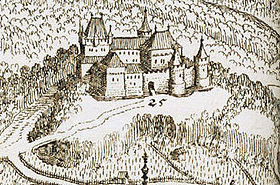Freiburg Castle
| Freiburg Castle on the Schlossberg | |
|---|---|

The motte-and-bailey castle in the Topographia Germaniae by Matthäus Merian
|
|
| Highest point | |
| Elevation | 376.3 m (1,235 ft) |
| Coordinates | 47°59′37.4″N 7°51′29.5″E / 47.993722°N 7.858194°ECoordinates: 47°59′37.4″N 7°51′29.5″E / 47.993722°N 7.858194°E |
| Geography | |
| Location | Baden-Württemberg, Germany |
| Parent range | Black Forest |
Freiburg Castle is a vanished castle. When it existed it was usually called the Burghaldenschloss (motte-and-bailey castle).
It stood on the Schlossberg (castle hill) above the city of Freiburg in Baden-Württemberg. The location was at 376.3 m (1,235 ft) above sea level around an elevation which today is called Ludwigshöhe. Beneath the Ludwigshöhe Roman stone mosaics were found in 1819. The remains of a Roman villa or fortress suggest that the mountain must already have been of strategic importance during the time of the Roman settlement of the Rhine Valley.
Already in 1091 the duke Berthold II of Zähringen ordered the construction of the Castrum de Friburch on the Schlossberg (castle hill) of Freiburg in beautiful Romanesque style. This castle was praised later by the poet Hartmann von Aue. The Duke's servants and craftsmen lived at the foot of the mountain in the area of what today is the southern part of the historic center, but it was only in 1120 when his son Konrad, with the approval of emperor Henry IV, granted the settlement market rights, thus ending the startup phase of Freiburg.
The existence of the castle is proved at least since 1146 when Bernhard of Clairvaux described in his travel diaries how he healed a blind boy apud castrum Frieburg (at the fort Freiburg). [1] To distinguish it from Zähringen castle above the village of the same name north of Freiburg this castle was called the Burghaldenschloss (motte-and-bailey castle). Throughout history, fires and acts of war on several occasions destroyed the fortified buildings on castle hill, but the castle was rebuilt various times by the respective rulers because of its strategic importance for the protection of Freiburg and to control the access to the Black Forest and the Dreisam valley.
...
Wikipedia

